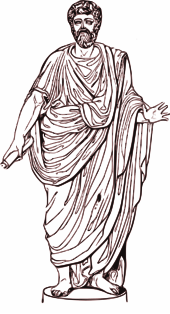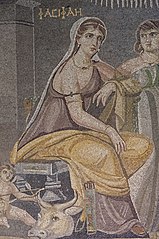Clothing in Ancient Rome
The costume in Ancient Rome consisted of two types of pieces like the Greek, called indutus or indumenta (the interior) and amictus (the exterior).
In the early days, the garments were reduced to the tunic, similar to the chiton of the Greeks and to the proper and exclusive toga of the Roman citizens who, for this reason, were called gens togata, while they they said of the Greeks gens paliata. Sometimes, they wore another inner tunic, called subucula, equivalent to our shirt, and the upper one was usually tied with a belt called cingulum or cinctus, closed with brooch or fibula. The toga was a wide woolen garment, elliptical cut, closed at the bottom and open at the top to the waist. When wearing it, it was picked up by the folds on the right side and slanted towards the left shoulder.
- His color was usually white or grey (alba, Candida), above all, in those who aspired to the judiciary; from where the name of candidates that today is in use in our language.
- Children and magistrates wore a toga adorned with purple strips (trabea, toga praetexta).
- The conquerors in their triumphal entrance dressed the toga with embroidered palms of gold (toga palmata).
- The emperors held the toga made entirely of purple (toga purpureaor with gold embroidery (toga picta).
Late 1st century
At the end of the first century of the Roman Empire, the pieces of the indutus were increased and modified, admitting the tunic with sleeves or manicata and the wide tunic without the shoulder right (exomis) for slaves and shepherds and something also the breeches or panties (bracae), imitating the Persians, Gauls and other peoples of the North. The most outstanding piece of the amictus that began to spread at the end of the 1st century was the penula, a cloak closed or also sewn in front that travelers adopted for shelter and defense of the rain (penula viatoria) and even the nobles who wore it long and made of precious fabric with ornaments of stripes and embroidery. It was also called planet with the meaning of wandering because it revolved around the body without fixation and since it lacked sleeves to make use of the arms with this garment they had to be raised on the sides up to the shoulders. Also added to the outer garments (at the same time that the toga was abandoned by almost everyone) was the overcoat or cape called lacerna, open at the front and fastened with a brooch or fibula and the alicula, a kind of cape, all of which were rich and splendid among powerful people.
Over the head
To cover the head, an edge or fold of the toga sometimes served, but the most common was the cucullus or hood, the mortarboard or cap (pileus, galerus) and hat. The cucullus was worn attached to another piece, such as the penula or the cape, already forming part of it (then called the cape bardocuculus), already so that it could be removed and put on at will. And as for the hat, it used to be made of felt and with large brims (causia) or smaller brims (petasus). In solemn acts, however, it was customary to go bareheaded, except for the priest when offering a sacrifice, who was always covered with some fold of the toga.
Shoes
The most common footwear among the Romans was the sandal (solea) tied with straps (corrigia) constituting the caliga set. But they also used the calceus, a kind of shoe with some varieties and worn by senators and other magistrates (these, red and those, black) and the campagnus or larger boot, also typical of nobles. The coturno was in use among the Romans, as well as among the Greeks.
Female clothing
Roman women wore a long, loose-fitting tunic, the stola, which had many folds and which, for noble matrons, was adorned with fringes or rich embroidery. Over it they wore the palla, a cloak similar to the toga viril that covered the back and, sometimes, the head. They also covered themselves with a bonnet called a mitre or with a veil (ricinum) or a hood.
Others
Pocket handkerchiefs, known by the names manipulum, sudarium, and mapula, and other major uses were worn by people of all classes and conditions. for the neck and shoulders, called amictus, orarium and palliolum. Strips of purple or another color, embroidered and applied from top to bottom, which were called clavi or clavus, were very frequent in people of both sexes as ornaments on outer garments., distinguished into angusticlavi and laticlavi, depending on whether they were narrow or wide, and also the calliculae or slices and rosettes of colored and embroidered cloth, which they were applied on the tunic or dress at different points.
The costume of the Spanish during the Roman domination was exclusively Roman, until at the beginning of the Middle Ages it was modified somewhat by the Goths and Byzantines. They used to have a headdress called a melo.
Military clothing
The Roman soldiers of the first centuries defended their head with the galea or leather helmet and metal plates and the trunk by means of armor also made of small plates. But after the conquest of Gaul, the cassis or metal helmet (used before by Celts and Iberians) with jugulars and neck guards and the chain mail for the trunk was adopted, although some special army corps they used particular armor:
- the vilites, light infantry bodies that started the first the attack carried ochre or metal shields (of bronze, usually) in the left leg
- the Until or Evening (worn with two jabalins) they carried ochre in the right leg because it was the one they advanced in fighting
- the legionaries the chest and back were protected with a lorigue or flexible steel strip tie and arm with a short bronze bracelet
- the good cavalry squads carried instead of the previous lorica squamata or pen, arranged in the form of metal scales sewn on leather or strong fabric.
The armor of any type was attached to the cingulum or cintum, a leather belt covered with metal and fastened with a fibula, from which the sword hung. This one also wore a bálteus pendant, typical of chiefs who was slanted across the chest from the right shoulder to the left side of the waist. The emperors and other high heads of the Roman militia used a two-piece breastplate (petal and back) decorated with reliefs and perfectly adapted to the trunk as it appears in their statues and on it they wore the paludamentum, a kind of long and baggy cloak that was in use during the Empire and at the same time they wore a crest or apex and a crest or crista on the helmet to the Greek way which was also proper and distinctive of the centurions.




